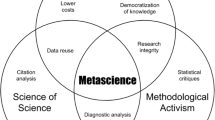Abstract
InThe Revolt of the Masses, JoseOrtega y Gasset suggests that the work of average or mediocre researchers plays a role in the advancement of science. In order to examine the “Ortega hypothesis” in sociology, lifework citations to scholars referred to in 5 of the most highly cited contemporary sociological articles are examined. The findings do not support the hypothesis. That is, few average scholars received citations to their work in these influential articles. This finding is consistent with similar analyses for physics and criminology.
Similar content being viewed by others
Notes and References
S. J. BENSMAN, Bibliometric laws and library usage as social phenomena, Library Research, 4 (1982) 279.
J. COLE and S. COLE,Social Stratification In Science, University of Chicago Press, Chicago, 1973, p. 216.
J. ORTEGA y Gasset,The Revolt Of the Masses, W. W. Norton & Company, New York, 1957, pp. 110–111.
J. COLE and S. COLE, op. cit., ref.2, 228.
H. ZUCKERMAN, R. MERTON, Age, aging and age structure in science, in: M. W. RILEY, M. JOHNSON, A. FONER (Eds),Aging And Society: Vol. III: A Sociology Of Age Stratification, Russell Sage Foundation, New York, 1972, p. 311.
G. S. GREEN, A test of the Ortega hypothesis in criminology,Criminology, 19 (1981) 49.
E. GARFIELD, The 100 articles most cited by social socientists, 1969–1977,Current Contents, 32 (7 August, 1978), 5.
E. GARFIELDref. 7.
M. OROMANER, The career of sociological literature: A diachronous study,Social Studies of Science, 7 (1977) 126–132; B. C. PERITZ, Are methodological papers more cited than theoretical or empirical ones? The case of sociology,Scientometrics, 5 (1983) 211–218.
The references to the 5 examined articles are: O. D. DUNCAN, Path analysis: sociological examples,American Journal of Sociology, 72 (1966) 1–16; A. W. GOULDNER, The norm of reciprocity: A preliminary statement,American Sociological Review 25 (1960) 161–178; W. S. ROBINSON, Ecological correlations and the behavior of individuals, American Sociological Review 15 (1950) 351–357; M. SEEMAN 24 (1959) 783–791; L. SROLE, Social integration and certain corollaries: An exploratory study,American Sociological Review 21 (1956) 709–716.
TheColes use the term “major author” for this individual See J. COLE and S. COLE,ref. 2, p. 227.
See ref. 11 (1966) 1–16
Peritz has found that sociological articles of a methodological nature are more frequently cited than are theoretical or empirical articles. Her finding is not inconsistent with the hypothesis proposed above.Peritz' finding is consistent with the suggestion that whether one is examining references in articles or citations to articles, it may be necessary to “control” for different types of articles. See B. C. PERITZ ref. 9
E. GARFIELD, Is citation analysis a legitimate evaluation tool?Scientometrics, 1 (1979) 365.
P. B. MEDAWAR,Advice to a Young Scientist, Harper & Row, New York, 1979, p. 67.
See R. K. MERTON,On the Shoulders of Giants: A Shandean Postrscript, The Free Press, New York, 1965.
See ref. 15Peritz has found that sociological articles of a methodological nature are more frequently cited than are theoretical or empirical articles. Her finding is not inconsistent with the hypothesis proposed above.Peritz' finding is consistent with the suggestion that whether one is examining references in articles or citations to articles, it may be necessary to “control” for different types of articles. See
S. P. TURNER and D. E. CHUBIN, Another appraisal of Ortega, the Coles, and science policy: The Ecclesiastes Hypothesis,Social Science Information 15 (1976) 657–662; S. P. TURNER and D. E. CHUBIN, Chance and eminénce in science: Ecclesiastes II,Social Science Information 18 (1979) 437–449.
TheColes do write of a “tentative conclusion” -ref. 2Social Stratification In Science, University of Chicago Press, Chicago, 1973, p. 234, whileGreen offers the “possibility that the number of works can be reduced without affecting the rate of advance” (ref. 6, p. 51). For a skeptical view concerning policy implications of citation analyses see M. O ROMANER, The quality of scholarship and the “graying” of the academic profession: A skeptical view,Research In Higher Education, 15 (1981) 231–239.
Author information
Authors and Affiliations
Rights and permissions
About this article
Cite this article
Oromaner, M. The Ortega hypothesis and influential articles in American sociology. Scientometrics 7, 3–10 (1985). https://doi.org/10.1007/BF02020136
Received:
Issue Date:
DOI: https://doi.org/10.1007/BF02020136




